The present study aimed to investigate the impact of hydrogen (H
2) on chronic intermittent hypoxia (CIH)-induced cardiac hypertrophy in mice by modulating iron metabolism. C57BL/6N mice were randomly allocated into four groups: control (Con), CIH, CIH + H
2, and H
2. The mice were exposed to CIH (21–5% FiO
2, 3 min/cycle, 8 h/d), and received inhalation of a hydrogen–oxygen mixture (2 h/d) for 5 weeks. Cardiac and mitochondrial function, levels of reactive oxygen species (ROS), and iron levels were evaluated. The H9C2 cell line was subjected to intermittent hypoxia (IH) and treated with H
2. Firstly, we found H
2 had a notable impact on cardiac hypertrophy, ameliorated pathological alterations and mitochondrial morphology induced by CIH (
p < 0.05). Secondly, H
2 exhibited a suppressive effect on oxidative injury by decreasing levels of inducible nitric oxide synthase (i-NOS) (
p < 0.05) and 4-hydroxynonenal (4-HNE) (
p < 0.01). Thirdly, H
2 demonstrated a significant reduction in iron levels within myocardial cells through the upregulation of ferroportin 1 (FPN1) proteins (
p < 0.01) and the downregulation of transferrin receptor 1 (TfR1), divalent metal transporter 1 with iron-responsive element (DMT1(+ire)), and ferritin light chain (FTL) mRNA or proteins (
p < 0.05). Simultaneously, H
2 exhibited the ability to decrease the levels of Fe
2+ and ROS in H9C2 cells exposed to IH (
p < 0.05). Moreover, H
2 mediated the expression of hepcidin, hypoxia-inducible factor-1α (HIF-1α) (
p < 0.01), and iron regulatory proteins (IRPs), which might be involved in the regulation of iron-related transporter proteins. These results suggested that H
2 may be beneficial in preventing cardiac hypertrophy, a condition associated with reduced iron toxicity.
Full article






